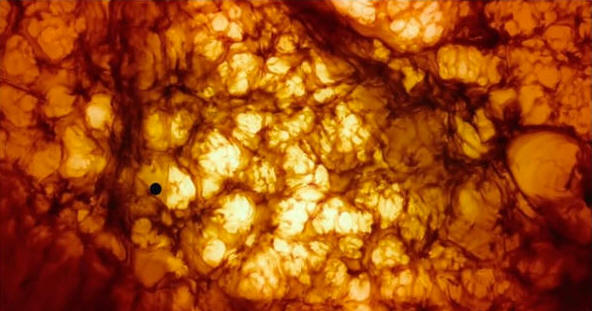MOVIE REVIEWS |
INTERVIEWS |
YOUTUBE |
NEWS
|
EDITORIALS | EVENTS |
AUDIO |
ESSAYS |
ARCHIVES |
CONTACT
|
PHOTOS |
COMING SOON|
EXAMINER.COM FILM ARTICLES
||HOME

Thursday, July 14, 2011
ESSAY
"The
Tree Of Life": A Multi-Part Exploration

Fox Searchlight
by
Omar P.L. Moore/PopcornReel.com
 FOLLOW
FOLLOW
Thursday,
July 14, 2011
INTRODUCTION
Cover
| Part One
| Two
| Three
As artistry in this young new century no feature film surpasses "The
Tree Of Life" as an enriching cinematic yet wondrously quizzical experience.
Terrence Malick's two hour, 18-minute masterpiece of collage, abstraction and
impressionism is a deeply spiritual and existential journey about life and
faith, and questions and answers about both.
Ever since its long-awaited arrival, Mr. Malick's film, shot entirely in
Smithtown, Texas in 2008, has polarized audiences, first at Cannes in May, where
it won the Palme D'Or amid some controversy, and audiences in the U.S., where a
fair share (about 3 or 4% -- an estimate) of moviegoers have departed.
Critics have been roughly 80% positive about Mr. Malick's film, which explores birth,
life, death, fatherhood, adolescence, motherhood, nature, grace, God, faith
and guilt. The Popcorn Reel
reviewed the film at length in May. (For those
who would rather watch a three-minute review instead, click
here.)
During its two hour, 18-minute running time "The Tree Of Life" contains roughly
20 minutes of dialogue. (Note that "2001: A Space Odyssey" contained less
than 40 minutes of dialogue over a slightly longer running time. The two
films have some similarities in rhythm, although "The Tree Of Life" is warmer
emotionally. A picture in a book, shown later in this essay, may be an
homage of sorts to Mr. Kubrick's film.)
Non-linear, Mr. Malick's film does not possess a
narrative that films typically do.
The music score by Alexandre Desplat is solemn, triumphant and nostalgic, and there
is music from Brahms and other legendary classists.
"The Tree Of Life", released theatrically in the U.S. in select cities on May 27, 2011, stars Brad Pitt as
Mr. O'Brien, a man who possesses numerous patents for an invention, who works at
an industrial machinist plant, Sean Penn as Jack, a man pained and guilty over
the loss of his middle brother years ago at the age of 19, and now married and
working as an architect. Jessica Chastain plays Mrs. O'Brien, the mother
of three boys, including Jack (played in youth by Hunter McCracken.)
Mr. Malick's film is set in 1950s Waco, Texas and in the present day.

A shot from Terrence Malick's drama
"The Tree Of Life".
Fox Searchlight
BACKGROUND
Terrence Malick's five films explore natural habitats as deeply as they do human
behavior. Cinematically, trees, leaves, sunsets, water, blades of grass
have never been adorned in as detailed and as abundant a manner as Mr. Malick
lenses them. Whether it's late cinematographer Nestor Almendros with "Days
Of Heaven", Tak Fujimoto in the earlier "Badlands", John Toll ("The Thin Red
Line") or Emmanuel Lubezki ("The New World" and "The Tree Of Life"), the
atmosphere is fully contemplated. Nature isn't a vacuum, especially in this,
the
director's fifth and current film. (Mr. Malick has finished shooting a
sixth film. There have been reports of a six-hour edition of "The Tree Of
Life" or longer.)
Mr. Malick's use of narration and whispers, mostly of questions, marks his
work.
You could stitch each of Mr. Malick's films together as one and they wouldn't look
out of place in a continuum of habitat, feel, mood, investigation and
contemplation. Together and apart each film is timeless, even as several,
if not all, are distinct period films.
"The Tree Of Life" is a film that, like all art, means so many things to so many
different people. Some adore this film, claiming it has changed their
lives in some way. Others absolutely detest the film, declaring that it
has no substance and is as empty as the hole in a donut. There's no real
middle ground. "The Tree Of Life" in my humble estimation, will be a
classic in 20 years. It's already a classic. It will gain the wide
respect and regard that "2001: A Space Odyssey" did not enjoy in its early days.
Many critics weren't impressed by that film when it was first released in 1968.
You can feel that "The Tree Of Life" is very personal to its director.
You can sense that the film is something that Mr. Malick has thought about for
many years, perhaps for as long as he can recall. Yet the film is an
unabashedly universal experience.
Across oceans. Across galaxies. "The Tree Of Life" encapsulates
nature, planets and the lives that revolve and struggle within those realms.
A nostalgic Garden of Eden is wrapped around the blips of narrative, some 25
minutes of total dialogue, including the trademark whispering voices that Mr.
Malick has been so fond of over the course of five films. The nature
scenes
include a most astonishing, extraordinary 18 minutes of breathtaking,
overwhelming imagery, which is somewhat reprised in 9 minutes in the latter half
of the film.
Click here for part one
Cover
| Part One
| Two
| Three
COPYRIGHT 2011. POPCORNREEL.COM. ALL RIGHTS RESERVED.  FOLLOW
FOLLOW
SUBSCRIBE TO THE POPCORN REEL MOVIE
REVIEWS RSS FEED

MOVIE REVIEWS |
INTERVIEWS |
YOUTUBE |
NEWS
|
EDITORIALS | EVENTS |
AUDIO |
ESSAYS |
ARCHIVES |
CONTACT
| PHOTOS |
COMING SOON|
EXAMINER.COM FILM ARTICLES
||HOME

 FOLLOW
FOLLOW
 FOLLOW
FOLLOW